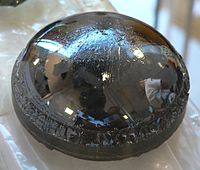
Photo from wikipedia
In this work, silicon and higher manganese silicide (HMS) bulk nanocomposites were synthesized, Si 100- x (HMS) x , where x is 10–50, and their thermoelectric properties were studied. The… Click to show full abstract
In this work, silicon and higher manganese silicide (HMS) bulk nanocomposites were synthesized, Si 100- x (HMS) x , where x is 10–50, and their thermoelectric properties were studied. The powders of Si and Mn in a stoichiometric ratio were mixed by a ball milling, followed by hot-pressing to obtain the Si + HMS bulk nanocomposite samples. Every bulk sample was highly dense, with a density of over 90% of its theoretical value. The x-ray diffraction analysis revealed that only the Si and HMS phases, without any impurity phase, were obtained. The fractured surface morphology showed that the composites consisted of micro-sized Si matrix grains with the HMS nanodots homogenously distributed within the grains. The thermoelectric studies showed that thermal conductivity decreased with a higher concentration of HMS, mainly due to the reduction of lattice thermal conductivity. It was believed to be the presence of the HMS nanodots which effectively scattered phonon transport. Furthermore, the addition of HMS increased charge carrier concentration. Hence, the Seebeck coefficient decreased, and the electrical conductivity increased with increasing HMS content. However, the presence of the HMS nanodots also contributed to strong scattering of charge carriers. The charge mobility was reduced significantly for the composite samples compared to the bulk Si sample. Therefore, the electrical conductivity is relatively low compared to the reported values in the literature. The dimensionless figure-of-merit (ZT) was improved in the nanocomposite samples compared to the bulk Si sample, and the values were largest for the sample with x = 50.
Journal Title: Journal of Electronic Materials
Year Published: 2020
Link to full text (if available)
Share on Social Media: Sign Up to like & get
recommendations!